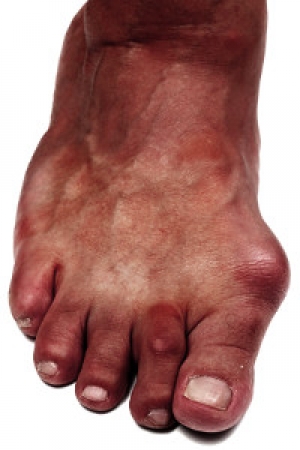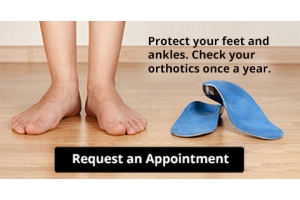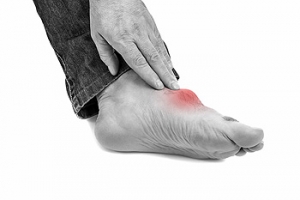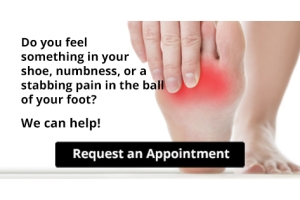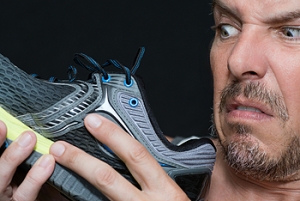Connect With Us
Featured Articles

What is a Bunion?
 A bunion is typically found at the bottom of the big toe. It is comprised of a growth that appears to be of a bony texture, and severe pain is often experienced. The causes for this ailment developing may originate from a predisposed inherited gene or from an injury the foot has endured. There are several ways to determine if you have this condition, which may be noticing reddened skin, a tingling sensation, or swelling in the affected area. Treatment typically involves specific surgery that can be performed to remove the bunion or choosing a more conservative method where partial relief may be obtained. Recent research has shown that wearing shoes with a bigger toe area is helpful in accommodating the bunion, in addition to pads that are placed on the bunion which may help in relieving pressure. Seeking a consultation with a podiatrist is highly recommended if you are experiencing pain or discomfort.
A bunion is typically found at the bottom of the big toe. It is comprised of a growth that appears to be of a bony texture, and severe pain is often experienced. The causes for this ailment developing may originate from a predisposed inherited gene or from an injury the foot has endured. There are several ways to determine if you have this condition, which may be noticing reddened skin, a tingling sensation, or swelling in the affected area. Treatment typically involves specific surgery that can be performed to remove the bunion or choosing a more conservative method where partial relief may be obtained. Recent research has shown that wearing shoes with a bigger toe area is helpful in accommodating the bunion, in addition to pads that are placed on the bunion which may help in relieving pressure. Seeking a consultation with a podiatrist is highly recommended if you are experiencing pain or discomfort.
If you are suffering from bunions, contact Dr. Thong V. Truong of California. Our doctor can provide the care you need to keep you pain-free and on your feet.
What Is a Bunion?
A bunion is formed of swollen tissue or an enlargement of boney growth, usually located at the base joint of the toe that connects to the foot. The swelling occurs due to the bones in the big toe shifting inward, which impacts the other toes of the foot. This causes the area around the base of the big toe to become inflamed and painful.
Why Do Bunions Form?
Genetics – Susceptibility to bunions are often hereditary
Stress on the feet – Poorly fitted and uncomfortable footwear that places stress on feet, such as heels, can worsen existing bunions
How Are Bunions Diagnosed?
Doctors often perform two tests – blood tests and x-rays – when trying to diagnose bunions, especially in the early stages of development. Blood tests help determine if the foot pain is being caused by something else, such as arthritis, while x-rays provide a clear picture of your bone structure to your doctor.
How Are Bunions Treated?
- Refrain from wearing heels or similar shoes that cause discomfort
- Select wider shoes that can provide more comfort and reduce pain
- Anti-inflammatory and pain management drugs
- Orthotics or foot inserts
- Surgery
If you have any questions, please feel free to contact our office located in Chico, CA . We offer the newest diagnostic and treatment technologies for all your foot care needs.
Bunions
A bunion is an enlargement of the base joint of the toe that connects to the foot, often formed from a bony growth or a patch of swollen tissues. It is caused by the inward shifting of the bones in the big toe, toward the other toes of the foot. This shift can cause a serious amount of pain and discomfort. The area around the big toe can become inflamed, red, and painful.
Bunions are most commonly formed in people who are already genetically predisposed to them or other kinds of bone displacements. Existing bunions can be worsened by wearing improperly fitting shoes. Trying to cram your feet into high heels or running or walking in a way that causes too much stress on the feet can exacerbate bunion development. High heels not only push the big toe inward, but shift one's body weight and center of gravity towards the edge of the feet and toes, expediting bone displacement.
A podiatrist knowledgeable in foot structure and biomechanics will be able to quickly diagnose bunions. Bunions must be distinguished from gout or arthritic conditions, so blood tests may be necessary. The podiatrist may order a radiological exam to provide an image of the bone structure. If the x-ray demonstrates an enlargement of the joint near the base of the toe and a shifting toward the smaller toes, this is indicative of a bunion.
Wearing wider shoes can reduce pressure on the bunion and minimize pain, and high heeled shoes should be eliminated for a period of time. This may be enough to eliminate the pain associated with bunions; however, if pain persists, anti-inflammatory drugs may be prescribed. Severe pain may require an injection of steroids near the bunion. Orthotics for shoes may be prescribed which, by altering the pressure on the foot, can be helpful in reducing pain. These do not correct the problem; but by eliminating the pain, they can provide relief.
For cases that do not respond to these methods of treatment, surgery can be done to reposition the toe. A surgeon may do this by taking out a section of bone or by rearranging the ligaments and tendons in the toe to help keep it properly aligned. It may be necessary even after surgery to wear more comfortable shoes that avoid placing pressure on the toe, as the big toe may move back to its former orientation toward the smaller toes.
What is Gout?
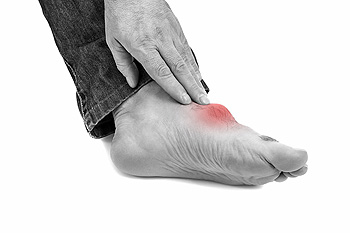 Gout is a form of arthritis, and there are several causes for this condition. If an excess amount of alcohol is frequently ingested, in addition to being overweight or having a predisposed inherited gene, gout may become a painful ailment to contend with. Food containing a large amount of purines, which may cause excess crystals to form and lodge in the joints, may be a source for this condition to occur. Extreme pain may become evident during an attack, accompanied with redness and swelling. Additional symptoms may include difficulty in moving the toe as a result of being stiff and tender. Bouts of this type of arthritis typically fade in 10 days, and recent research has suggested that there’s inconclusive evidence if and when another attack will reappear. If you are suffering from this affliction, please consult your podiatrist for prevention techniques, which may include dietary changes that are beneficial for you.
Gout is a form of arthritis, and there are several causes for this condition. If an excess amount of alcohol is frequently ingested, in addition to being overweight or having a predisposed inherited gene, gout may become a painful ailment to contend with. Food containing a large amount of purines, which may cause excess crystals to form and lodge in the joints, may be a source for this condition to occur. Extreme pain may become evident during an attack, accompanied with redness and swelling. Additional symptoms may include difficulty in moving the toe as a result of being stiff and tender. Bouts of this type of arthritis typically fade in 10 days, and recent research has suggested that there’s inconclusive evidence if and when another attack will reappear. If you are suffering from this affliction, please consult your podiatrist for prevention techniques, which may include dietary changes that are beneficial for you.
Gout is a foot condition that requires certain treatment and care. If you are seeking treatment, contact Dr. Thong V. Truong from California. Our doctor will treat your foot and ankle needs.
What Is Gout?
Gout is a type of arthritis caused by a buildup of uric acid in the bloodstream. It often develops in the foot, especially the big toe area, although it can manifest in other parts of the body as well. Gout can make walking and standing very painful and is especially common in diabetics and the obese.
People typically get gout because of a poor diet. Genetic predisposition is also a factor. The children of parents who have had gout frequently have a chance of developing it themselves.
Gout can easily be identified by redness and inflammation of the big toe and the surrounding areas of the foot. Other symptoms include extreme fatigue, joint pain, and running high fevers. Sometimes corticosteroid drugs can be prescribed to treat gout, but the best way to combat this disease is to get more exercise and eat a better diet.
If you have any questions please feel free to contact our office located in Chico, CA . We offer the newest diagnostic and treatment technologies for all your foot and ankle needs.
Everything You Need to Know About Gout
Gout, typically found in diabetic patients, is an unusually painful form of arthritis caused by elevated levels of uric acid in the bloodstream. The condition typically strikes the big joint on the big toe. It has also been known to strike the knees, elbows, fingers, ankles and wrists—generally anywhere that has a functioning, moving joint.
The high level of uric acid in a person’s bloodstream creates the condition known as hyperuricema—the main cause of gout. Genetic predisposition occurs in nine out of ten sufferers. The children of parents who suffer gout will have a two in ten chance of developing the condition as well.
This form of arthritis, being particularly painful, is the leftover uric acid crystallizing in the blood stream. The crystallized uric acid then travels to the space between joints where they rub, causing friction when the patient moves. Symptoms include: pain, redness, swelling, and inflammation. Additional side effects may include fatigue and fever, although reports of these effects are very rare. Some patients have reported that pain may intensify when the temperature drops, such as when you sleep.
Most cases of gout are easily diagnosed by a podiatrist’s assessment of the various symptoms. Defined tests can also be performed. A blood test to detect elevated levels of uric acid is often used as well as an x-ray to diagnose visible and chronic gout.
Treatment for gout simply means eliminating symptoms. Non-steroid anti-inflammatory drugs or NSAIDs (Colchicine and other corticosteroid drugs, etc.) will quell the redness, the swelling, and the inflammation. However, managing your diet, lifestyle changes, and using preventative drugs are all helpful toward fully combating the most severe cases.
Those that lead an inactive lifestyle are at a higher risk for gout. Any amount of exercise decreases the probability of repeat encounters with the condition. Reducing your consumption of red meat, sea food, and fructose-sweetened drinks also reduces the likelihood of chronic gout as well.
Ingesting Vitamin C, coffee, and particular dairy products can help with maintaining a healthy lifestyle. There are new drugs out on the market that inhibit the body’s production of uric acid-producing enzymes. However, reducing or eliminating your overall levels of uric acid is the best remedy to ensuring you lead a gout-free life.
Why Live with Pain and Numbness in Your Feet?
Possible Treatment Options for Hyperhidrosis of the Feet
 There are many triggers in the environment that stimulate glands to produce sweat, which include warm temperatures, exercise, fear, and nervousness. A condition referred to hyperhidrosis consists of excessive sweating and may require specific treatments that will enable the patient to tolerate this condition. Typically, the sweat glands become overactive, and this may occur for several reasons, including a predisposed inherited gene, infections, or a hormone imbalance. It’s important to obtain a proper diagnosis, and certain medical tests are generally performed to accomplish this. Topical or oral medications are often prescribed to stop excessive sweating. For more severe cases, it may be necessary to perform surgery, which can alter the nerves that produce sweat. If you suffer from this affliction, please consult with a podiatrist for a proper diagnosis and the best treatment options for you.
There are many triggers in the environment that stimulate glands to produce sweat, which include warm temperatures, exercise, fear, and nervousness. A condition referred to hyperhidrosis consists of excessive sweating and may require specific treatments that will enable the patient to tolerate this condition. Typically, the sweat glands become overactive, and this may occur for several reasons, including a predisposed inherited gene, infections, or a hormone imbalance. It’s important to obtain a proper diagnosis, and certain medical tests are generally performed to accomplish this. Topical or oral medications are often prescribed to stop excessive sweating. For more severe cases, it may be necessary to perform surgery, which can alter the nerves that produce sweat. If you suffer from this affliction, please consult with a podiatrist for a proper diagnosis and the best treatment options for you.
If you are suffering from hyperhidrosis contact Dr. Thong V. Truong of California. Our doctor can provide the care you need to attend to all of your foot and ankle needs.
Hyperhidrosis of the Feet
Hyperhidrosis is a rare disorder that can cause people to have excessive sweating of their feet. This can usually occur all on its own without rigorous activity involved. People who suffer from hyperhidrosis may also experience sweaty palms.
Although it is said that sweating is a healthy process meant to cool down the body temperature and to maintain a proper internal temperature, hyperhidrosis may prove to be a huge hindrance on a person’s everyday life.
Plantar hyperhidrosis is considered to be the main form of hyperhidrosis. Secondary hyperhidrosis can refer to sweating that occurs in areas other than the feet or hands and armpits. Often this may be a sign of it being related to another medical condition such as menopause, hyperthyroidism and even Parkinson’s disease.
In order to alleviate this condition, it is important to see your doctor so that they may prescribe the necessary medications so that you can begin to live a normal life again. If this is left untreated, it is said that it will persist throughout an individual’s life.
A last resort approach would be surgery, but it is best to speak with your doctor to find out what may be the best treatment for you.
If you have any questions please feel free to contact our office located in Chico, CA . We offer the newest diagnostic and treatment technologies for all your foot and ankle needs.
Hyperhidrosis of the Feet
Hyperhidrosis of the feet, also termed plantar hyperhidrosis, is characterized by excessive sweating of the feet that can be onset by any cause, such as exercise, fever, or anxiety. Most people suffering from hyperhidrosis of the feet also experience hyperhidrosis of the hands, or palmar hyperhidrosis. Approximately 1-2% of Americans suffer from this disorder.
Sweating is a healthy process utilized by the body in order to cool itself and maintain a proper internal temperature, which is controlled by the sympathetic nervous system. In individuals with hyperhidrosis, the sympathetic nervous system works in "overdrive", producing far more sweat than is actually needed.
Plantar hyperhidrosis is considered primary hyperhidrosis. Secondary hyperhidrosis refers to excessive sweating that occurs in an area other than the feet, hands, or armpits, and this indicates that is related to another medical condition, such as menopause, hyperthyroidism, or Parkinson's disease.
Symptoms of hyperhidrosis of the feet can include foot odor, athlete's foot, infections, and blisters. Because of the continual moisture, shoes and socks can rot which creates an additional foul odor and can ruin the material, requiring shoes and socks to be replaced frequently. In addition to the physical symptoms, emotional health is often affected as this disorder can be very embarrassing.
If left untreated, hyperhidrosis will usually persist throughout an individual's life. However, there are several treatment options available. A common first approach to treating hyperhidrosis of the feet is a topical ointment. Aluminum chloride, an ingredient found in antiperspirants, can be effective at treating hyperhidrosis if used in high concentration and applied to the foot daily. Some individuals can experience relief this way, while others encounter extreme irritation and are unable to use the product. Another procedure is the use of Botulinum Toxin A, commonly referred to as Botox. This is injected directly into the foot, and is effective at minimizing the sweat glands in the injected area. These injections must be repeated every 4 to 9 months.
If these treatments are ineffective, oral prescription medications may be taken in an effort to alleviate the symptoms. Again, some will experience relief while others do not. Going barefoot reportedly provides relief for most sufferers.
A final approach to combating hyperhidrosis of the feet is through surgery. Surgery has been less successful on patients with plantar hyperhidrosis than on those with palmar hyperhidrosis. It is only recommended when sweating is severe and other treatments have failed to work. This kind of surgery usually involves going into the central nervous system, and cutting nerves to stop the transmission of signals telling the foot to sweat.
Symptoms of Flat Feet
 A condition referred to as flat feet is a result of arches that have dropped. It can cause a feeling of tiredness in the feet and ankles, in addition to moderate aches and pains. If the entire foot touches the ground while standing, chances are favorable that you may have this ailment. The purpose of the arch is to raise the middle of the foot, which is comprised of tendons, bones, ligaments, and muscles. When the arch develops correctly, the foot is able to balance, walk, and run, in addition to the ability to absorb any physical shock the feet may endure. Most babies are born with flat feet that generally disappear as the child progresses in age. There are several reasons why this condition may occur in adults, including injuries that affect the joints and tissues, damage the foot or ankle may have incurred, or a predisposed inherited gene. If pain is experienced or you have noticed the arches have collapsed, contact your podiatrist.
A condition referred to as flat feet is a result of arches that have dropped. It can cause a feeling of tiredness in the feet and ankles, in addition to moderate aches and pains. If the entire foot touches the ground while standing, chances are favorable that you may have this ailment. The purpose of the arch is to raise the middle of the foot, which is comprised of tendons, bones, ligaments, and muscles. When the arch develops correctly, the foot is able to balance, walk, and run, in addition to the ability to absorb any physical shock the feet may endure. Most babies are born with flat feet that generally disappear as the child progresses in age. There are several reasons why this condition may occur in adults, including injuries that affect the joints and tissues, damage the foot or ankle may have incurred, or a predisposed inherited gene. If pain is experienced or you have noticed the arches have collapsed, contact your podiatrist.
Flatfoot is a condition many people suffer from. If you have flat feet, contact Dr. Thong V. Truong from California. Our doctor will treat your foot and ankle needs.
What Are Flat Feet?
Flatfoot is a condition in which the arch of the foot is depressed and the sole of the foot is almost completely in contact with the ground. About 20-30% of the population generally has flat feet because their arches never formed during growth.
Conditions & Problems:
Having flat feet makes it difficult to run or walk because of the stress placed on the ankles.
Alignment – The general alignment of your legs can be disrupted, because the ankles move inward which can cause major discomfort.
Knees – If you have complications with your knees, flat feet can be a contributor to arthritis in that area.
Symptoms
- Pain around the heel or arch area
- Trouble standing on the tip toe
- Swelling around the inside of the ankle
- Flat look to one or both feet
- Having your shoes feel uneven when worn
Treatment
If you are experiencing pain and stress on the foot you may weaken the posterior tibial tendon, which runs around the inside of the ankle.
If you have any questions please feel free to contact our office located in Chico, CA . We offer the newest diagnostic and treatment technologies for all your foot and ankle needs.
